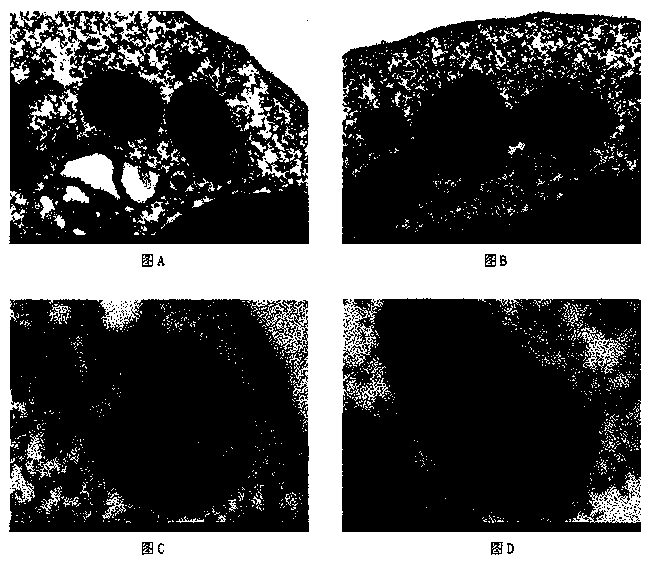Application of ATPIF1 gene silenced T cells in preparation of antitumor drugs
An anti-tumor drug, gene silencing technology, applied in the field of biomedicine
- Summary
- Abstract
- Description
- Claims
- Application Information
AI Technical Summary
Problems solved by technology
Method used
Image
Examples
Embodiment 1
[0025] Mouse B16 tumor inoculation experiments
[0026] 1), take 8 mice from group A and group B respectively, inject B16 tumor cells in the armpit, divide the 8 mice in group A into group A1 and group A2 equally, and the 8 mice in group B are all Divided into group B1 and group B2;
[0027] 2) Three days later, mice in groups A2 and B2 were intraperitoneally injected with CD8 antibody, and then injected intraperitoneally with CD8 antibody every three days to eliminate CD8 in mice. + The role of T cells;
[0028] 3), 14 days later, kill the mice in groups A1, A2, B1, and B2 to take out the melanoma;
[0029] Compare the size and weight of melanoma in each group of mice, see the attached figure 1 , among them, Figure A is the size comparison picture of the melanoma taken out of the two kinds of mice, and Figure B is the weight comparison of the melanoma, it can be seen that ATPIF1 - / - Compared with wild-type mice, the tumors in mice were smaller and lighter, and tumor growt...
Embodiment 2
[0031] Isolation and purification of mouse CD8 + T cells
[0032] 1. Preparation of spleen cells
[0033] 1) Take 34 5cm cell culture dishes, respectively labeled as A1, A2, A3...A17, B1, B2, B3...B17, add PBS (0.1% BSA + 0.6% Sodium citrate) 5 mL, put a cell strainer in each cell culture dish, take 17 mice from each group A and B and kill them, take out the spleen and put them in the strainer, grind the tissue with the back of the syringe, Rinse the filter screen regularly with PBS;
[0034] 2) Transfer the ground spleen cell suspension to a 15ml centrifuge tube with a pipette, fill it with cold PBS, and centrifuge at 1300rpm for 10 minutes;
[0035] 3) Discard the supernatant, resuspend the cell suspension in 15ml of cold PBS, and centrifuge for 10 minutes;
[0036] 4) Repeat the previous step and wash 3 times;
[0037] 2. Lysis of mouse red blood cells
[0038] 1) Each spleen was resuspended with 5ml erythrocyte lysis buffer;
[0039] 2) Incubate on ice for 5 minute...
Embodiment 3
[0062] Carboxyfluorescein diacetate succinimidyl ester (CFSE) monitoring T lymphocyte proliferation
[0063] 1) Take the A1, A2, A3, A4, A5, A6 and B1, B2, B3, B4, B5, B6 centrifuge tubes in Example 2, centrifuge and discard the supernatant, and the T cells in each tube are resuspended in 5% Heat-inactivated serum (FBS) in 1 mL of 1640 medium with T cell concentration at 5 x 10 6 / ml;
[0064] 2) Thoroughly resuspend each tube of T cells in 1 mL volume of 1640 medium containing 2% serum, carefully put into the bottom of a fresh (not wetted) 15 mL centrifuge tube;
[0065] 3) Place the tube horizontally (using an unwetted tube will prevent the 1 mL cell suspension from moving and mixing with the CFDA, SE solution prematurely);
[0066] 4) Carefully add 110 μL PBS to the non-wetted part of the plastic at the top of the tube, making sure it does not come into contact with the cell solution;
[0067] 5) Resuspend 1.1 μL of 5mM CFDA in 110 μL PBS;
[0068] 6) Cap the tube quick...
PUM
 Login to View More
Login to View More Abstract
Description
Claims
Application Information
 Login to View More
Login to View More - R&D
- Intellectual Property
- Life Sciences
- Materials
- Tech Scout
- Unparalleled Data Quality
- Higher Quality Content
- 60% Fewer Hallucinations
Browse by: Latest US Patents, China's latest patents, Technical Efficacy Thesaurus, Application Domain, Technology Topic, Popular Technical Reports.
© 2025 PatSnap. All rights reserved.Legal|Privacy policy|Modern Slavery Act Transparency Statement|Sitemap|About US| Contact US: help@patsnap.com



